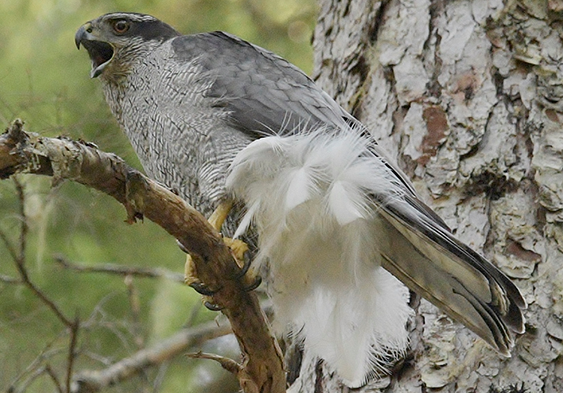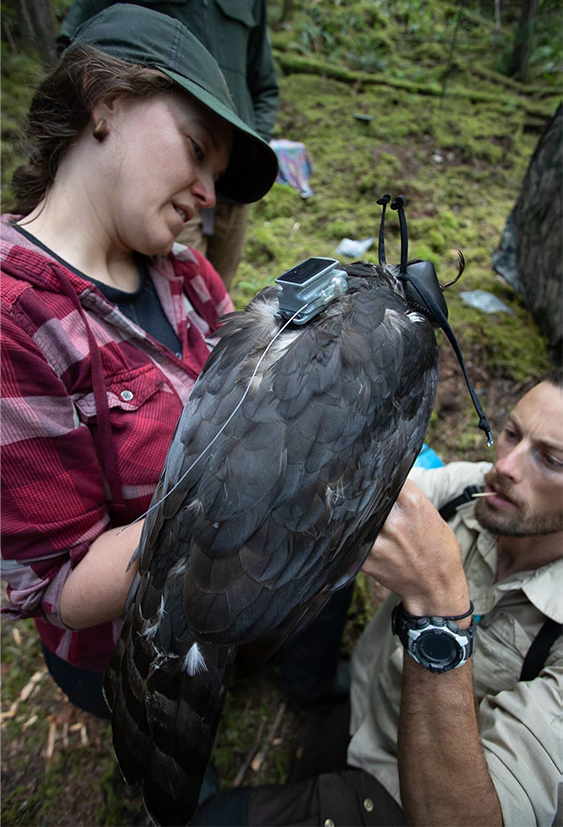Northern Goshawk
The Northern Goshawk is a species of conservation concern in B.C. due to its need for large areas of mature and old forest for breeding and foraging. The Province is working with the forest industry, educational institutions, and Indigenous communities to learn more about these birds, protect suitable habitats, and inform land use decisions.
On this page:
- What is a Northern Goshawk?
- Conservation status and protection measures
- Implementation and management actions
What is a Northern Goshawk?
The Northern Goshawk (Accipiter gentilis) is the largest accipiter hawk in British Columbia. This hawk has short, rounded wings and a long tail, which helps it maneuver through the mature and old forest it selects for nesting and foraging.
Two subspecies are recognized in B.C. The coastal subspecies (Accipiter gentilis laingi) occurs along the northwest coast of North America from Washington to Alaska, with the entire Canadian population found in British Columbia. The interior subspecies (Accipiter gentilis atricapillus) occurs throughout most of mainland B.C. east of the Coast Ranges.
Conservation status and protection measures
The coastal Northern Goshawk subspecies has been listed as threatened under the federal Species at Risk Act since 2003, based on Committee on the Status of Endangered Wildlife in Canada (COSEWIC) assessments in 1995, 2000 and 2013. The coastal subspecies is categorized as red (at risk of being lost) in B.C. and is identified as a species at risk under the provincial Forest and Range Practices Act. The interior Northern Goshawk subspecies is not listed under the federal Species at Risk Act; however, it is categorized as blue (special concern) in B.C. The size of the ‘transition zone’ in which these two subspecies overlap is unclear. A better understanding of these subspecies' distributions is important to support effective conservation and inform land management decisions.
Like other birds, both subspecies of Northern Goshawk, their occupied nests, and eggs are legally protected from harm under B.C.'s Wildlife Act. Due to its federal status as a threatened species, the coastal Northern Goshawk and its nests are also protected under the federal Species at Risk Act. Northern Goshawk habitat can be protected under provincial legislation, particularly the Forest and Range Practices Act, Oil and Gas Activities Act, and Land Act.
Implementation and management actions
The main threat to Northern Goshawk’s breeding and foraging habitat is the loss and fragmentation of mature and old forests.
The provincial implementation plan for the recovery of coastal Northern Goshawk lays out the goals and actions to ensure that viable populations persist across their range in British Columbia. Key actions include the protection of breeding areas, and research on foraging habitat needs. The Province has established over 19,400 hectares of wildlife habitat areas (WHAs), currently focused on breeding habitat. The Province has also formed a joint technical working group with the Haida Nation to focus on Stads K’un recovery in Haida Gwaii.
- Implementation Plan for the Recovery of Northern Goshawk, laingi Subspecies (Accipiter gentilis laingi) in British Columbia – 2018 (PDF, 0.9MB)
- Coastal Northern Goshawk Wildlife Habitat Areas (WHAs) established under the Government Actions Regulation of the Forest and Range Practices Act
- Coastal Northern Goshawk Wildlife Habitat Areas (WHAs) established under the Environmental Protection and Management Regulation of the Oil and Gas Activities Act
- Land Use Objectives for Haida Gwaii, including Objectives for Coastal Northern Goshawk Habitat
- Land Use Objectives for the Cranberry Sustainable Resource Management Plan Area, including Objectives for Interior Northern Goshawk Habitat


